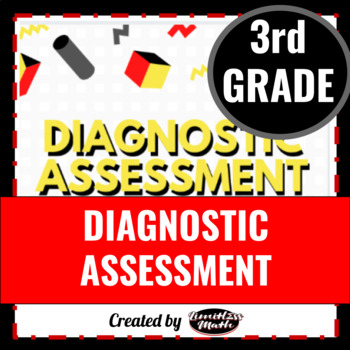Math Diagnostic Assessment 3rd Grade
Limitless Math
15 Followers
Grade Levels
2nd - 4th
Subjects
Resource Type
Standards
CCSS3.MD.A.1
CCSS3.MD.A.2
CCSS3.MD.B.3
CCSS3.MD.B.4
CCSS3.MD.C.5
Formats Included
- PDF
Pages
19 pages
Limitless Math
15 Followers
Description
This diagnostic assessment is strategically designed to help you evaluate students' understanding of mathematical standards.
What's Included?
- (36)-Question Diagnostic
- Answer Key
- Individual Records Form - to assist you in instructional decisions and placement to improve student performance.
This diagnostic assessment can be given at the beginning of the course or when a new student arrives. It assesses the core skills that are most associated with on-grade success. The results will provide information about the intervention that students will need to be successful in learning the mathematics related to the standards for this grade level and course.
The Limitless Math system measures student progress over time and allows you to collect data timely and make effective instructional recommendations.
Total Pages
19 pages
Answer Key
Included
Teaching Duration
N/A
Last updated Apr 28th, 2020
Report this resource to TPT
Reported resources will be reviewed by our team. Report this resource to let us know if this resource violates TPT’s content guidelines.
Standards
to see state-specific standards (only available in the US).
CCSS3.MD.A.1
Tell and write time to the nearest minute and measure time intervals in minutes. Solve word problems involving addition and subtraction of time intervals in minutes, e.g., by representing the problem on a number line diagram.
CCSS3.MD.A.2
Measure and estimate liquid volumes and masses of objects using standard units of grams (g), kilograms (kg), and liters (l). Add, subtract, multiply, or divide to solve one-step word problems involving masses or volumes that are given in the same units, e.g., by using drawings (such as a beaker with a measurement scale) to represent the problem.
CCSS3.MD.B.3
Draw a scaled picture graph and a scaled bar graph to represent a data set with several categories. Solve one- and two-step “how many more” and “how many less” problems using information presented in scaled bar graphs. For example, draw a bar graph in which each square in the bar graph might represent 5 pets.
CCSS3.MD.B.4
Generate measurement data by measuring lengths using rulers marked with halves and fourths of an inch. Show the data by making a line plot, where the horizontal scale is marked off in appropriate units-whole numbers, halves, or quarters.
CCSS3.MD.C.5
Recognize area as an attribute of plane figures and understand concepts of area measurement.





